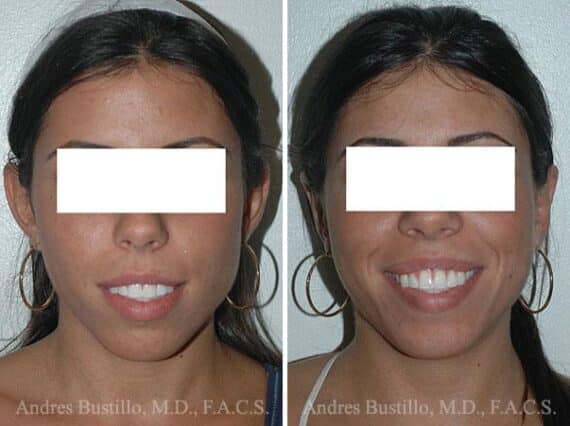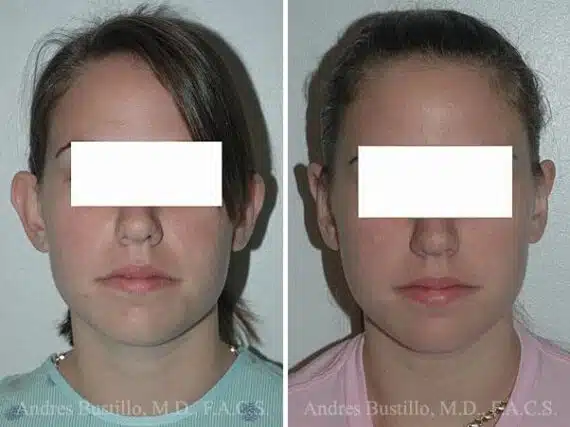If you’ve recently had otoplasty or are thinking about scheduling surgery, understanding the otoplasty recovery timeline is key to feeling prepared. Also known as cosmetic ear surgery or ear pinning surgery, otoplasty can provide a permanent improvement in the shape or position of your ears. But like any surgical procedure, the healing process takes time—and knowing what to expect during recovery can make a big difference.
At Dr. Andres Bustillo’s practice in South Florida, patients receive personalized care from a double board-certified facial plastic surgeon with years of experience performing otoplasty. In this blog, we’ll guide you through each phase of otoplasty recovery, from post-op care to your final results, so you know how to plan, heal, and get the best outcome possible.

What You’ll Learn About Otoplasty Recovery
- You’ll wear a bandage for the first few days, followed by a headband.
- Most swelling and bruising improves after the first week.
- Final results can be seen after 2 to 3 months.
- Taking care of your incisions, avoiding sun exposure, and following your surgeon’s instructions are essential.
- Dr. Bustillo offers expert surgical care and a smooth recovery process tailored to your needs.
How Otoplasty Surgery Is Performed
Otoplasty is a cosmetic procedure designed to improve the shape, proportion, or position of the ears. It’s often performed on patients who have ears that stick out prominently or are misshapen due to genetics or injury. The otoplasty procedure usually involves making a small incision behind the ear, allowing the surgeon to reshape the cartilage and reposition the ears closer to the head.
The surgery is typically done under local anesthesia with sedation and takes about two hours. Once complete, the ears are bandaged to support healing and protect the new shape
Otoplasty Recovery Timeline
The recovery process after otoplasty is generally straightforward, but it’s important to follow your plastic surgeon’s post-operative instructions carefully. Here’s what to expect during each stage of healing.
Day 1–3
In the first few days after otoplasty surgery, your ears will be wrapped in a protective bandage. This dressing helps minimize swelling, maintain the new position of the ears, and prevent infection. You may feel mild to moderate discomfort, but prescription medications can help manage this. It’s essential to rest, keep your head elevated, and avoid any pressure on your ears.
Immediate Post-Op
Week 1
After a few days, Dr. Bustillo will remove the bulky bandages and replace them with a soft headband, which should be worn at all times except when showering. Swelling and bruising may still be present, but most patients begin to feel more comfortable. It’s important not to sleep on your sides and to avoid touching or bumping your ears.
Visible Healing During the First Week
Weeks 2-3
Swelling continues to improve during the second and third weeks of otoplasty recovery. You’ll likely only need to wear the headband at night during this stage, but follow your surgeon’s instructions. The incision lines behind the ears will begin to fade, and you’ll start to see the new contour of your ears.
Swelling Subsides
Months 2-3
By the second or third month after your otoplasty surgery, most swelling will have resolved, and the ears will have settled into their final position. You’ll see the full results of your cosmetic ear surgery, and the incisions will continue to fade. By now, you can enjoy your new look with confidence.
Final Results Visible
Managing Pain and Discomfort after Otoplasty
Mild soreness, tightness, or itching around the ears is common after surgery. Over-the-counter pain medications or prescriptions provided by your surgeon can keep discomfort under control. Be gentle with your ears and avoid any activity that puts pressure on them.
How to Reduce Swelling and Bruising
To help reduce swelling and speed up healing:
- Keep your head elevated, especially when sleeping.
- Apply cold compresses as directed.
- Avoid bending over or heavy lifting during the first week.
- Stick to a low-sodium diet to minimize fluid retention.
- Avoid alcohol and smoking, which can delay healing.
Why Choose Dr. Andres Bustillo for Your Otoplasty Procedure?
Dr. Andres Bustillo is a double board-certified facial plastic surgeon with over 15 years of experience. Known for his meticulous surgical techniques and natural-looking results, Dr. Bustillo offers a patient-first approach and comprehensive care. He performs otoplasty surgery in his state-of-the-art facility and provides clear post-op instructions to ensure a smooth recovery and exceptional outcomes.
What to Eat During Recovery
A healthy diet supports healing after otoplasty. Focus on:
- High-protein foods like eggs, lean meats, and legumes.
- Fruits and vegetables rich in vitamins A and C to support skin healing.
- Plenty of water to stay hydrated.
Avoid:
- Salty foods, which can increase swelling.
- Sugary snacks and processed foods.
- Alcohol and caffeine in the first few days.
Resuming Regular Activities
Knowing when to get back to your normal routine is an important part of your otoplasty recovery.
- Work or school: Most patients can return within 5–7 days, depending on their comfort and job type.
- Hair washing and styling: You can wash your hair with shampoo a few days after surgery once your surgeon removes the initial dressings.
- Exercise: Light walking is okay after a few days, but avoid strenuous workouts for at least 2–3 weeks.
- Wearing glasses or headphones: Avoid pressure on the ears until fully healed. Use soft bands or place the stems carefully above or behind the ears as advised.
- Helmets: Refrain from wearing helmets or tight headgear for at least 4–6 weeks.
Questions about your procedure?
Schedule a consultation with Dr. Andres Bustillo.
Potential Complications to Watch For
While rare, complications can occur. Call your surgeon if you experience:
- Persistent or increasing pain
- Signs of infection (redness, warmth, or discharge)
- Fever
- Unusual swelling or bleeding
- Sudden asymmetry in ear shape
Prompt treatment can prevent long-term issues and support a successful recovery.
What to Avoid During Otoplasty Recovery
For the best healing results, avoid:
- Sleeping on your side
- Touching or pulling on your ears
- Wearing earrings or ear piercings too soon
- Excessive sun exposure to incision sites
- Smoking and alcohol
- Wearing pullover clothing that could disturb healing—opt for button-downs or zip-ups

Scar Management Tips
To keep incision lines as unnoticeable as possible:
- Use topical ointments or scar gels recommended by your surgeon.
- Avoid sun exposure or use sunscreen on healed incisions.
- Don’t pick at scabs or peeling skin.
- Attend all follow-up appointments to monitor healing.
Consult with an Expert Facial Plastic Surgeon
If you’re considering otoplasty or are in the middle of your recovery, expert care makes all the difference. Dr. Bustillo’s focus on facial plastic surgery ensures you receive the highest level of care and results that look natural. Schedule your consultation today to learn more about the otoplasty procedure and start your journey toward greater confidence.
Otoplasty Recovery FAQs
It’s best to wait at least 6 to 8 weeks before wearing earrings or considering a new ear piercing. Always check with your surgeon before proceeding, especially if the piercing is close to the surgical site.
You can usually wash your hair with shampoo a few days after surgery, but swimming should be avoided for at least 4 to 6 weeks to reduce the risk of infection or irritation. Check with your surgeon before returning to water activities.
Most patients can travel by air within one to two weeks after otoplasty, once the initial healing phase has passed. Be cautious of pressure changes and avoid contact or pressure on your ears during travel.



